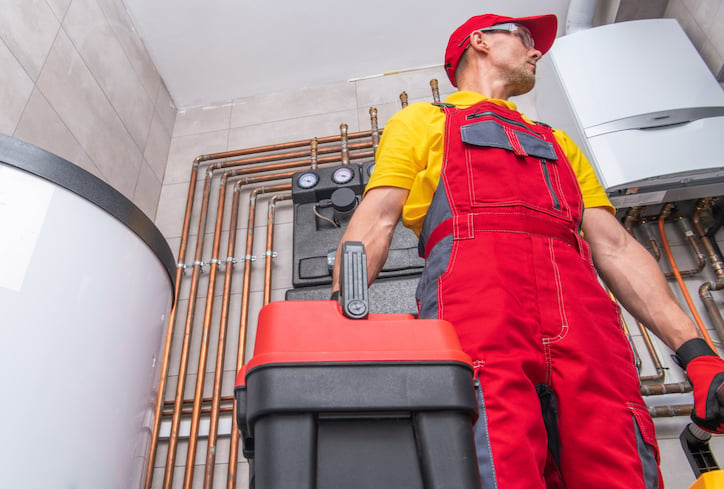When relying on physical assets for your business, the decision to repair or replace aging and broken equipment comes down to minimizing overall cost. While it may seem less costly to fix an asset rather than spend a larger sum upfront to purchase a new one, you should decide based on the overall replacement asset’s value. Let’s use a commercial HVAC system as an example when caught in a repair vs. replace conundrum and dig into how HVAC service work order software can help.
The last thing you want is machinery affected by intense cold when the heater goes out or staff getting ill due to heat exhaustion in the summer when the air conditioning is broken. Plus, with many facilities installing air scrubbers and additional ventilation over the last few years due to COVID-19 protocols, the need for air filters and a more conscious system for air purification adds an entire additional sub-system. Equipment replacement may be inevitable in some circumstances, but conducting a replacement analysis can help you gauge whether or not this expense is necessary or if maintenance costs would ultimately help extend the asset's remaining life.
Ask yourself the following questions when considering asset replacement or repair costs for your HVAC systems.
Repair or Replace: How Much Have We Spent So Far in Maintenance Costs?
Ease headaches involved in your decision-making process by analyzing repair costs of current or older equipment to see if a new asset is really worth it. Take a peek back in your CMMS and calculate the average repair cost and the total investment of each asset. Look at items such as parts needed, shipping and other costs for obtaining the correct parts, and repair labor for your staff. Review built-in HVAC service work order software for a log of past repairs and the time and expense required for each task. Did you need to call in a specialist? If so, note that cost as well. This gives you a baseline to predict what future costs may total.
Replacement Cost Analysis: What Will a New System Cost?
Replacing equipment sounds scary when you look at the upfront price tag if new models, especially when adding labor costs and installation expenses. A large facility with expansive ductwork — or multiple facilities with numerous systems — will cost more than a smaller office space.
On average, commercial HVAC replacement costs can total between $5,000 and $12,000. The unit itself is only a portion of the cost, ranging from $4,000 to $8,000. If you’re hiring an outside specialist for the installation, the cost can be $75-$150 per hour per person. Then, you have to determine if new ductwork is needed. If so, your replacement project can total around $15,000 or even $20,000 with additions like zones or humidifiers (and considering their market value).
If you decide to replace your equipment rather than repair it, there will be some costs involved with disposing of the old asset. Refrigerators, for example, require more careful and costly disposal; it’s not as simple as throwing them in the garbage.
Once you identify the replacement cost estimate, you have two numbers to compare: your historical repair costs, with the frequency of repairs so that you can estimate future expenses and the estimated replacement cost.
Additional Replacement Analysis: What Extra Costs Do We Need To Consider?
Outside of parts and labor market value, you’ll need to consider the operating costs of downtime. Both replacing and repairing machinery leads to periods of inactivity and production loss—it’s unavoidable. We all know that downtime costs money, so the potential for facility downtime should be a major consideration when deciding whether to repair or replace equipment.
Use a repair or replace calculator to estimate how long your downtime might be and how much of your facility that will impact it. This can help guide your decision to conduct maintenance on your equipment or replace it outright. You also want to consider the cost of additional training for your staff when installing a new or upgraded unit. Upgrades and manufacturer changes can create a need to re-train maintenance technicians on how to repair it and even other employees on how to use it.
Tapping into the HVAC service work order software in your CMMS can help reduce these costs. For example, you can upload manuals, training videos, detailed notes and photos for each new piece of equipment to give your technicians the tools they need to install and utilize new assets properly. But again, adding these to your system and giving staff time to absorb the information will take time. It will, however, significantly reduce the time spent constantly repairing old, outdated and weakened equipment and pushing other projects down on the list.

Making the Final Repair or Replace Decision
You need to have a clear picture of what your assets have cost you so far, their repair history, when they were purchased and their life expectancy. Using this data to predict asset performance can help save your organization thousands of dollars annually. You can determine if a costly repair is worth the expense, or if other factors may lead you toward replacing equipment instead.
Access reporting features in your CMMS to review the number of repairs made on a piece of equipment, how long each repair has taken overall operating costs and the total expenses of each asset.
This data will help you determine if the costs outweigh the price of a new piece of machinery. If you’re ready to access robust reporting on each of your assets to make the repair or replacement decision easier, book some time to see Maintenance Care’s CMMS with included asset management in action.









